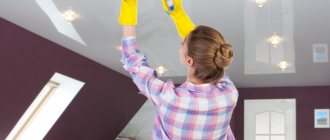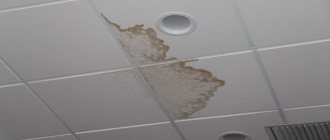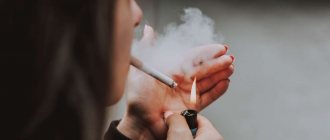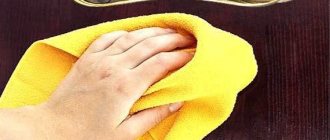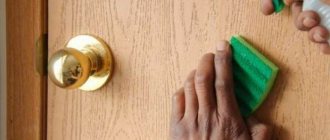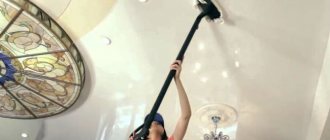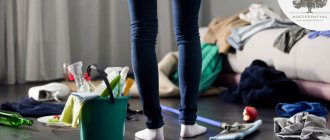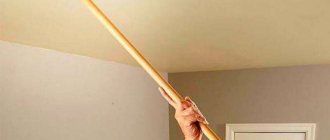An excellent way to create coziness in an apartment is suspended ceilings. The material of the ceiling covering creates the effect of ideal purity, shine and celebration. The design pleases the eye with its purity of color and bold design ideas. Therefore, the appearance of stains, dust and dirt on it is upsetting. There is a desire to immediately get rid of the annoying obstacle. There are a lot of ideas on how to wash a plastic ceiling in order to return it to the freshness of newness. There is no need to start cleaning until you are familiar with the cleaning products. Try to find out the cause of the contamination and possible ways to remove it.
Types of plastic ceiling coverings
Before you wash the ceiling coverings, you need to clarify what type they are to ensure proper cleaning. There are two types of suspended ceilings:
- Glossy with a pattern. They are easy to clean.
- Plain matte. They are cleaned using the dry method (with a damp soft cloth and a vacuum cleaner). It is better not to install such panels in the kitchen, since stains are easily absorbed into the material.
Suspended ceilings are most often made in white. Keeping plastic panels clean takes effort.
White plastic ceiling
Wood-look plastic suspended ceiling
Glossy plastic ceiling
Thanks to the varnish coating, plastic ceiling panels are highly wear-resistant. Additionally, they have an antiseptic effect, UV resistance, and scratch resistance.
Necessary tools and cleaning products for cleaning the ceiling
To wash a plastic ceiling yourself, first of all you need to pick up the simplest tools:
- water container, taking into account the addition of detergents to it
- a soft cloth, several rags (rags are better)
- latex gloves
- foam sponge
- a special mop with a soft, replaceable cloth or microfiber tip
- brush with natural bristles (for cleaning the ceiling in the kitchen)
You may also need a vacuum cleaner to remove dust first. This will prevent the formation of streaks.
[custom_ads_shortcode3]
Causes of contamination of suspended ceilings
Ceilings made of plastic panels become dirty for reasons that do not always depend on the carefulness of the owners. Plastic coatings gradually lose their shine and newness for the following main reasons:
- From black spots left by insects.
- Marks left during repairs in the form of dots of cement, paint and glue.
- Steam condensation in the kitchen and bathroom, containing particles of chlorine and limescale, which, when dry, form stains.
- Rust stains from leaking ceiling pipes.
- Brown residue of tobacco smoke.
- Grease deposits (in the kitchen) in the form of stains.
- Leaking roofs.
- Collecting dust.
Contaminants are removed in different ways and means. Use a different product for each type of stain.
Why do stains appear on ceilings?
9 reasons for stains on ceilings:
- Dust. As the dust gradually covers the ceiling, it can harden and add hassle to cleaning the ceiling.
- Evaporation. In the kitchen and bathroom, condensation accumulates on the ceiling due to the evaporation of hot water. Impurities contained in water, such as chlorine and lime, other alkalis and salts, leave stains when the steam dries.
- Fat deposits. In addition to water, fats and oils evaporate in the kitchen. Reaching the ceiling, they cool and form sticky spots that attract dust very well.
- Precipitation. Owners of apartments on the top floors and owners of houses sometimes become victims of leaking roofs. Precipitation seeps through leaky floor slabs and leaves dirty and rusty stains on the ceilings.
- Careless neighbors can also cause stains on ceilings by forgetting to turn off the bathroom faucet.
- Faulty pipes. Rusty dirt appears on the ceiling due to leaking pipes. Moreover, sometimes a pipe can burst in one place and leak in another, since water flows through the cavity of concrete slabs and appears where there are defects in the ceiling. In this case, it is better to save your nerves and call specialists.
- Insects. Flies and mosquitoes that fly into the house during ventilation leave behind black dots.
- Tobacco smoke tends to spread on the ceiling in a thin brownish, greasy coating. In addition to stains, cigarette smoke also leaves an unpleasant odor.
- Repair. The ceiling may be stained with wallpaper paste or paint during a fresh renovation. It is much worse when stains appear due to poorly executed old repairs. Violation of putty and grout technology leads to the formation of contaminants that can only be removed by refinishing.
How to remove dirt from suspended ceilings
To remove simple dirt from a suspended plastic ceiling, use a cloth soaked in water. For convenience, fill a basin with water and place it on the counter or stool from which you will wash the ceiling. If water fails, use heavy artillery.
Detergents should be in liquid or gel form, without large abrasive particles that leave scratches. Before cleaning your plastic ceiling, choose a product from a reputable brand. After reading the instructions, make a solution of the appropriate concentration.
Elimination of causes
As they say, it’s clean not where they clean, but where they don’t litter. This statement fully applies to the ceiling. To get rid of the problem of stains on the coating, it is necessary to eliminate the causes of their appearance.
Here's what you need for this:
- Equip windows with mosquito nets. This will prevent flies from entering the apartment and will significantly reduce the entry of street dust into the premises.
- Install forced exhaust in rooms with high humidity. The steam, without reaching the surface, will go into ventilation shafts.
- Equip the stove on which food is prepared with a powerful hood that will collect fatty fumes on its filters. They are much easier to clean than the ceiling.
- No smoking indoors. If you do this, then near the switched on hood.
- Deal with leaking roof and pipes. This will not only prevent further stains from appearing, but will also rid the apartment of unnecessary dampness.
Installing a hood in the kitchen
As they say, it’s clean not where they clean, but where they don’t litter. This statement fully applies to the ceiling. To get rid of the problem of stains on the ceiling, it is necessary to eliminate the causes of their appearance.
- Equip windows with mosquito nets. This will prevent flies from entering the apartment and will significantly reduce the entry of street dust into the premises.
- Install forced exhaust in rooms with high humidity. The steam, without reaching the ceiling, will go into ventilation shafts.
- Equip the stove on which food is prepared with a powerful hood that will collect fatty fumes on its filters. They are much easier to clean than the ceiling.
- No smoking indoors. If you do this, then near the switched on hood.
- Deal with leaking roof and pipes. This will not only prevent further stains from appearing, but will also rid the apartment of unnecessary dampness.
Products for removing heavy dirt from plastic ceilings
To clean a suspended ceiling, use the following popular plastic cleaners:
- Glorix floor cleaner also quickly cleans plastic ceiling surfaces and destroys mold. Dilute it in water and leave it on the surface of the ceiling for 5-15 minutes, then simply rinse with a damp soft cloth.
- "Cif Cream" perfectly removes stubborn dirt, lime deposits, and rust. He cleans the ceiling without streaks.
- Detergents “Mr.Muscle” and “Mr.Proper” foam well and do not leave streaks.
- “LOC” is a functional product (“Amway”) that cleans all surfaces. Does not need to be washed off with water. The solution is prepared by mixing thirty milliliters of the product with five liters of water. After using it, it is not necessary to wash the panels with water; it is enough to simply dry them.
- Alcohol-containing high-gloss cleaners and glass cleaners.
Glorix is easy to use. Suitable for light cleaning
Cif Cream removes traces of rust well
Products easily remove simple stains
Functional LOC will remove any stain from your ceiling.
Cleaning slatted ceilings
Slatted ceilings mean a suspended frame structure, the structure of which is shown in the photo below. Slatted ceilings can be with or without layout. The trim is a decorative thin panel that is inserted between the main panels and serves to cover the joint.
How and with what to wash the ceiling before painting with water-based paint
You can wash the slatted ceiling in several ways:
- Without disassembly,
- With partial disassembly,
- With complete disassembly.
These types of ceilings are most often used in the bathroom, hallway, living room or kitchen. Washing ceilings without disassembling is considered preventive and is often quite enough for the bathroom to wipe away limescale residue from splashes of water. The best means for preventive cleaning in this case are glass sprays, which wash stains well and do not leave streaks if you use a cotton rag.
In the kitchen, such washing is not enough, since grease and soot settle in a dense layer and over time form accumulations of dirt in the seams of the ceiling. In these cases, partial disassembly of the ceiling is required, during which it is necessary to independently dismantle the layout panels, scrub the panel itself with a singing agent and wash the main lamellas, after which the layout is inserted back. Complete disassembly is used in case of heavy and difficult to remove contamination.
Do-it-yourself products for cleaning plastic suspended ceilings
Plastic ceilings can be washed not only with special chemicals. DIY solutions are suitable for these purposes. They do not lag behind in results from purchased chemicals.
- A melamine sponge, which has excellent cleaning properties, is considered an excellent tool for removing greasy stains. It is capable of removing any dirt and stains, including traces of ink, markers, and felt-tip pens. To do this, soak it in water and wipe the stained area.
- Plastic panels are washed with ammonia and water. Add one tablespoon of alcohol to 1 liter of water. Dip a rag or sponge in the solution and wipe the ceiling with it.
- Chlorine bleach is used to remove yellow stains. The composition is prepared from ten liters of water and 2-3 tablespoons of the product. Cleaning is carried out with a clothes brush.
- Traces of fat can be removed with vodka or table vinegar.
- Soda solution removes all types of contaminants. If the contamination is severe, then lubricate the contaminated area with slightly moistened soda with water. Leave the stain for 1-2 hours. Then remove the baking soda with a soft cloth.
- To make a universal solution for washing the ceiling, use soap shavings (30-40 g) diluted with water.
Do not use washing powder or sink cleaners to clean plastic ceilings. They have an aggressive effect on the material.
Home methods for dealing with contamination of PVC panels
To clean the panels, you don’t have to look for products in the store and spend money. Take a look at your home supply of products and find what you need for effective cleaning.
- How to clean a leather sofa: dark and light, care and hygiene
- Stains appeared on linoleum: how to remove and how to remove them
- Sewer pipe cleaner: how to rinse and remove blockages
Soap
A soap solution will help remove stubborn grease and food stains.
Recipe:
- Liquid dishwashing gel 2 tbsp. pour into container.
- Grind 100 grams of laundry soap on a grater. add to the gel.
- Pour in 1 liter. warm water.
- Stir well.
Moisten a soft sponge or rag in the resulting solution and wipe the surface.
Soda
It is used for complex stains; it easily dissolves stubborn nicotine and old greasy stains without leaving any traces.
How to prepare washing powder: dilute the required amount of soda with water to a paste.
Moisten a sponge in the resulting paste and apply to the dirty area. Leave to act for several hours, then clean and rinse with running water. Wipe with a dry cloth.
Use the product carefully. Soda consists of tiny particles that can scratch the plastic and lose its visual appeal.
Vinegar and alcohol
These 2 components are ideal for maintaining plain panels. Capable of removing heavy stains.
Do not use liquids on products with printed designs!
To tidy up the panels, you need to moisten a sponge in a small amount of alcohol, vodka or vinegar 9%. Rub well. Rinse off with cool water.
If you need to wash colored plastic ceilings or walls, dilute vinegar with water in a ratio of 1:3. Test the reaction on a small, inconspicuous area before applying.
Ammonia
An ammonia solution can be used to clean a window, window sill, or polymer surface. Removes various contaminants and makes the surface shiny.
How to use:
- Prepare a solution: 1 liter of water. and alcohol 1 tbsp.
- Soak a cloth in the liquid and rub the plastic.
- Remove residues with clean water and wipe dry with a lint-free cloth.
Using folk recipes, start washing with the most gentle formulations, and, as necessary, move on to aggressive ones.
Sequence of work for cleaning the surface of a suspended ceiling
Any work is done quickly and easily if its sequence is strictly followed. It represents a certain algorithm:
- Start your plastic ceiling cleaning job by ensuring safety. Wear a hat and work clothes. Protect your hands with rubber gloves. This is necessary to avoid allergies to cleaning products and detergents, drying out the skin on your hands and injury.
- Test a corner of the plastic to determine its reaction to detergents. Leave it for a while. If there are no negative effects on the surface of the material, begin cleaning.
- Before washing, you need to clean the surface of suspended ceilings with a vacuum cleaner so that large particles of dirt do not cause mechanical damage to the ceiling surface.
- To soften dirt, the suspended ceiling is moistened with a warm soapy solution.
- Then carefully rub off the stains.
- The surface is washed abundantly.
- Then dry.
- To give the plastic shine, the clean glossy surface is wiped with a special polishing compound.
Such a powerful disinfection can return not only ideal cleanliness to the ceiling, but also refresh the living space.
Do not use detergents containing abrasive particles to clean plastic suspended ceilings; they will leave scratches on the smooth surface of the material. Do not use hot water to wash the plastic surface, as this will cause the panel to deform.
Care after washing
To keep the glossy ceiling still shiny and looking like new, a variety of polishes are suitable. They will not only improve the appearance, but also eliminate and fill microdamages on the surface.
In between wet cleaning, you can go over the surface with a vacuum cleaner. But here you need to be careful not to scratch it with a hard brush or the edge of the tube.
A good option is to vacuum the ceiling immediately before wet cleaning. This will remove all stuck particles with sharp edges from it.
The seams between the panels are cleaned of dust and dirt with a rubber spatula or a soft brush that will not damage the edges. You can apply the same detergents to it that were used on the main plane of the panels.
Pollution in the bathroom of an apartment where a small child lives
Sometimes the housewife is faced with such a problem as drawings with felt-tip pens, pencils and ballpoint pens on the plastic panels of the bathroom.
The following recipe will help in this case:
- For cleaning, a sulfur match head is used, which is soaked briefly in water.
- All contaminated areas are treated with this paste, after which they must be left for some time until traces of the handle disappear.
- The sulfur is washed off with a regular soap solution.
And if children accidentally found a solution of brilliant green and not only got dirty themselves, but also smeared the walls in the bathroom, you can use a bleaching agent.
But for colored surfaces, the test is first carried out in an inconspicuous place. Having selected the desired concentration of the product, you can safely wash away the dirt with this solution.
Types of panels
Before washing plastic PVC panels from dirt and limescale, you should determine their type. There are two types of panels: matte and glossy.
Glossy panels are coated with a special varnish that protects the coating from external negative environmental influences, so the plastic can withstand vigorous cleaning. The same cannot be said about matte panels. Due to their coating structure, the panels are more susceptible to contamination and are also sensitive to cleaning with chemicals, as a result of which they may lose their design and brightness of colors. It is for this reason that matte PVC panels are less popular than glossy ones.
It is worth noting that matte panels are recommended to be cleaned exclusively with a vacuum cleaner and dry cleaning.
Where to start and how to wash
All advice on this issue is quite conditional and cannot be an accurate guide to action. However, there are requirements that must be met:
- Before starting work, it is necessary to clear the room of unnecessary objects;
- Use a vacuum cleaner to remove dust from the ceiling;
- Then you should rinse the ceiling with clean warm water. After this, you can apply any version of the solution described above and leave it on the surface for some time (3-5 minutes). Gently wash the ceiling with a sponge or rag;
- Before drying, you need to wash it again with water;
- Wipe the ceiling with a soft flannel or rag, changing rags often to avoid streaks.
In living rooms, the plastic ceiling is easy to clean if it is regularly cleaned with a vacuum cleaner.
[custom_ads_shortcode3]
Soda Ash and Washing Powder
This way you can bleach small plastic items. To do this, you need to take 1 tablespoon of soda ash, the same amount of any washing powder, dissolve them in 1 liter of warm water. Soak yellowed objects in the resulting solution for 10-12 hours. After this, rub thoroughly with a sponge or napkin and wash under running water. If you need to increase the volume of water, then do not forget to maintain the proportion.
Features of cleaning plastic
Powders with abrasive particles, as well as hard and metal brushes are absolutely not suitable for caring for plastic panels. These products can cause scratches and minor damage to the surface, which will contribute to the accelerated accumulation of dirt and the formation of limescale.
Before you start washing, you need to stock up on the following cleaning items:
- Soft acrylic sponges.
- Foam sponges.
- Rags made of soft fabric.
- Acrylic sponges.
Caring for plastic and preventing contamination in the kitchen
Suitable compositions for cleaning plastic panels placed on the ceiling and walls from tobacco smoke:
- Vinegar with vodka. Used for ceilings without a pattern. Rinse off with cool water.
- Soap solution. To tidy up the ceiling, use laundry soap with a low alkali content, otherwise the appearance of the product will suffer.
- Bleach. To bleach yellowed plastic, use a solution and 2-3 tbsp. White and 10 l. water. To avoid streaks and streaks, distribute in one direction.
- Melamine sponge. To activate the active substances, just wet the sponge and clean.
The procedure is carried out in compliance with important rules:
- Do not use knives, sharp objects, or brushes with hard bristles.
- Do not use abrasive substances.
- Do not wash the ceiling with mops or other similar devices.
- Do not press on the surface to avoid the formation of dents.
- Do not use acetone or products containing it.
An important condition for maintaining the aesthetic appearance of the finish is not to use acids! They corrode the coating, erase the color and design! Be careful when choosing household cleaning products!
Cleaning PVC panels is easy by regularly cleaning and wiping off any spills. Grease and dirt come off the plastic, but tobacco smoke and rust are considered difficult stains and special measures are taken to remove them. An arsenal of homemade “penny” remedies will restore cleanliness to your home. They are safe and easy to use.
The choice of “clothing” for walls and ceilings is always difficult. Especially if it concerns the kitchen, bathroom or toilet. Wallpaper or tiles? Or maybe just paint? Yes, but they also have certain disadvantages. Such an original approach as plastic panels can save the situation.
If the contamination is serious, you can rub it more vigorously - the appearance of the plastic will not be affected. To get rid of greasy stains, it is good to wipe with an ammonia solution, but only in the area of contamination.
Despite all the moisture resistance, it is unacceptable to leave spilled puddles for a long time. Therefore, immediately after wet cleaning, you need to wipe the surface with a dry cloth.
To improve attractiveness and restore shine, it is worth using special products, for example, plastic polishes. Ease of use and high-quality end result - wipe with a cloth and you're done! Moreover, most of them are safe for contact with food products.
The second type? Dry cleaning is best for them. This can be wiping with a soft cloth or cleaning with a vacuum cleaner. Grease stains or other heavy dirt will be difficult to wash off. Therefore, this type of panel is not recommended for use in the kitchen. In this case, it is best to remove the contamination as soon as it appears, otherwise it may become absorbed over time, and then the plastic will hardly be helped in any way.
That's all the secrets. If you know about plastic panels, cleaning won’t seem like a terrible beast and all the problems about sloppiness in the kitchen or children’s pranks with paints will evaporate.
Very often, during general cleaning of the house, housewives simply do not know how to wash the plastic panels on the ceiling, in the bathroom, in the kitchen or in the rooms. You should not immediately take on household chemicals, which are too expensive and harmful to health. To clean PVC without streaks, you can use available home remedies such as ammonia, baking soda, table vinegar, vodka, or prepare a homemade cleaning solution.
This home remedy dissolves grease and soot especially well, so you can use it to clean the kitchen ceiling of grease without streaks.
To clean plastic with soda, you need to:
- Dilute 3 tbsp. l. baking soda with water to form a paste.
- Soak a kitchen sponge in the paste and clean the PVC.
- The baking soda should be left for several hours to dissolve all the fat.
- Finally, the surface should be washed with a wet cloth.
You should wash plastic panels with baking soda very carefully, as particles of the product can leave small scratches on the surface.
To wash wall surfaces, you need to determine in advance the degree of contamination and prepare everything you need, put on gloves and hats. Each type of cladding has its own characteristics, but there are general cleaning rules.
When working, you should adhere to a certain order:
- Provide a convenient approach to the walls, move furniture and washing machine, remove paintings, clocks, lamps. This will make the job easier and prevent the possibility of injury.
- Do not use hot or cold water; its temperature should not be higher than 40 °C.
- Clean the seams between the panels with a rubber spatula or a soft brush. These same tools are suitable for removing grease and dirt in corners near a table or stove.
- If chemicals are used, test the surface in an inconspicuous area by applying a small amount and waiting 5-10 minutes.
- Remove traces of paint and ink, remove grease stains and other contaminants, keeping in mind that, unlike plastic, MDF panels cannot be washed with products containing chlorine or alkali.
- Clean façade reliefs with a brush or sponge. Clean the main surface with detergent or a solution of washing powder. Finally, rinse everything with clean water and wipe dry.
When you're done cleaning the plastic panels, apply polish to brighten colored tiles and add shine to white ones.
General cleaning is carried out at least once a year. To maintain cleanliness, you need to wipe the walls monthly with a damp cloth.
- Laminated.
- Non-laminated.
You need to know exactly what material your panels are made of and then your task will become easier. Laminated plastic has a certain film protection and therefore is much easier to clean than non-laminated plastic.
